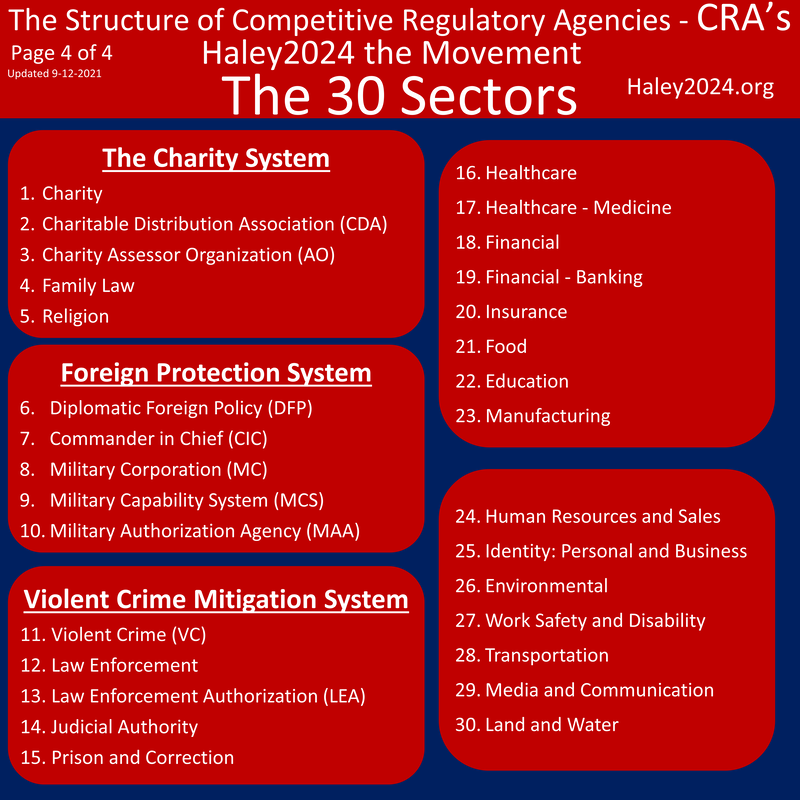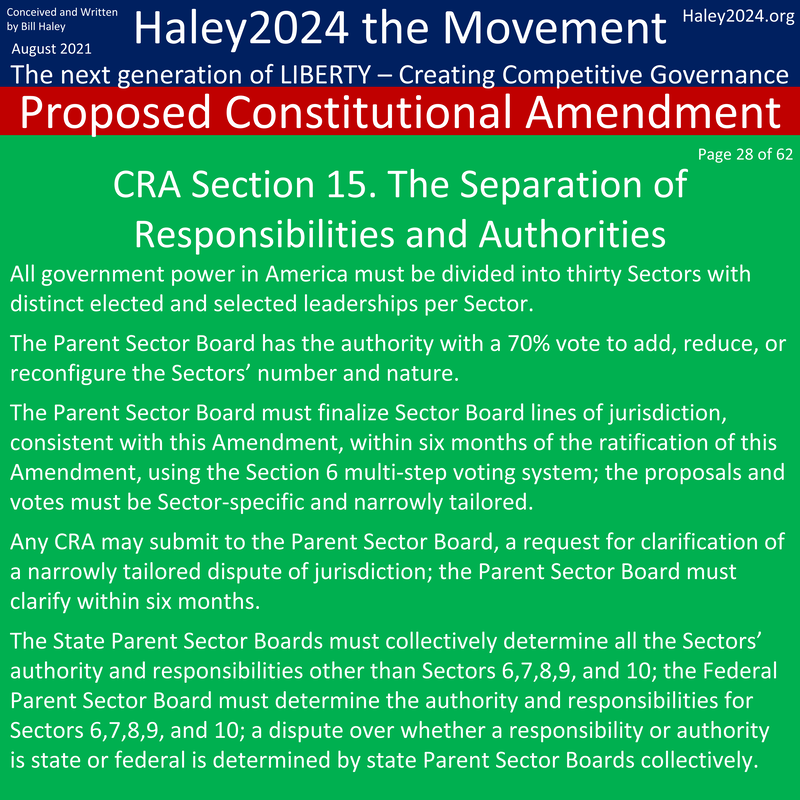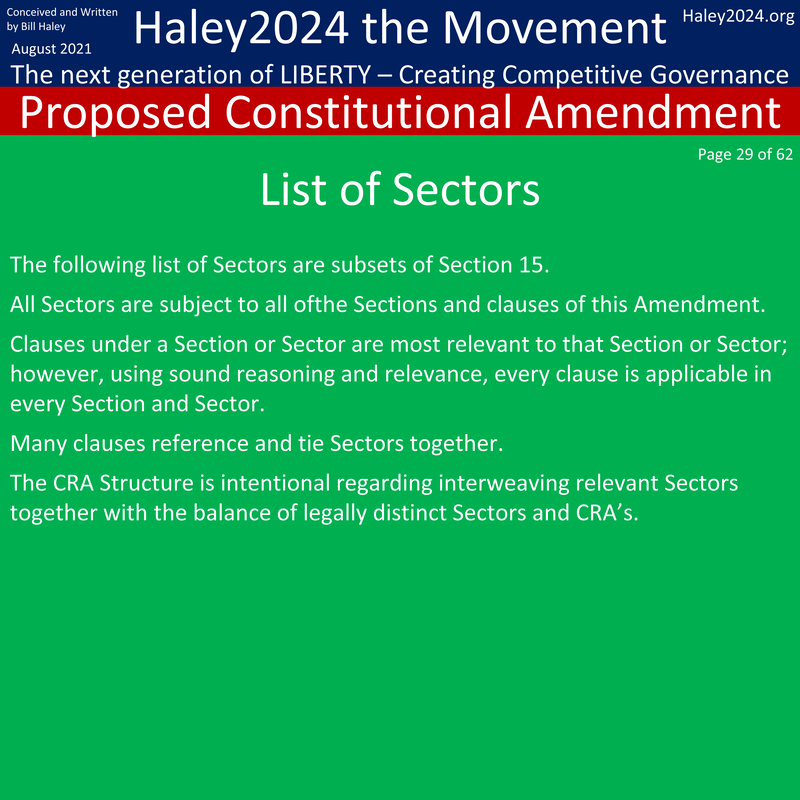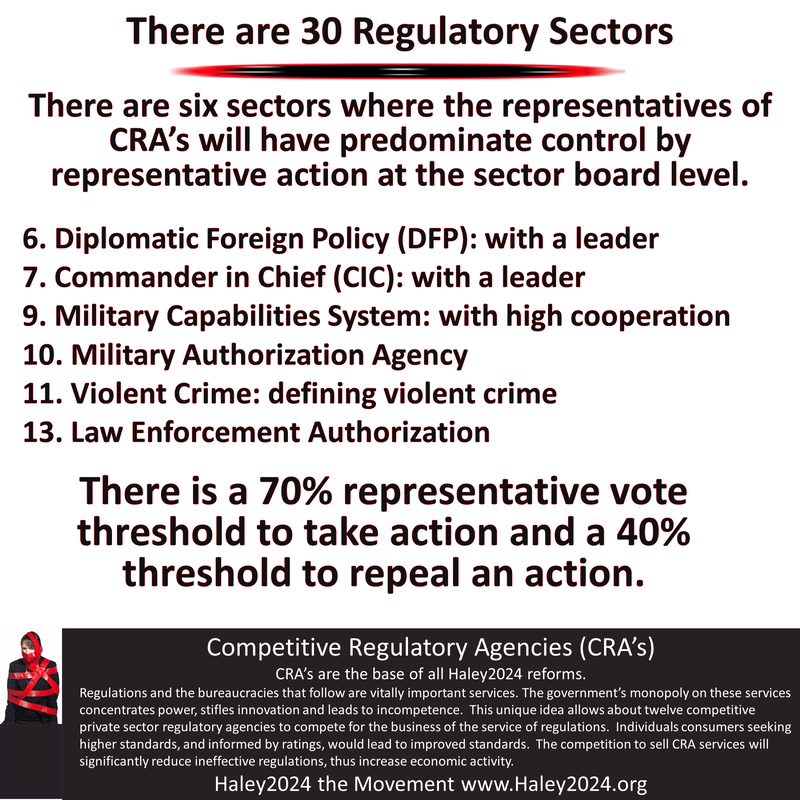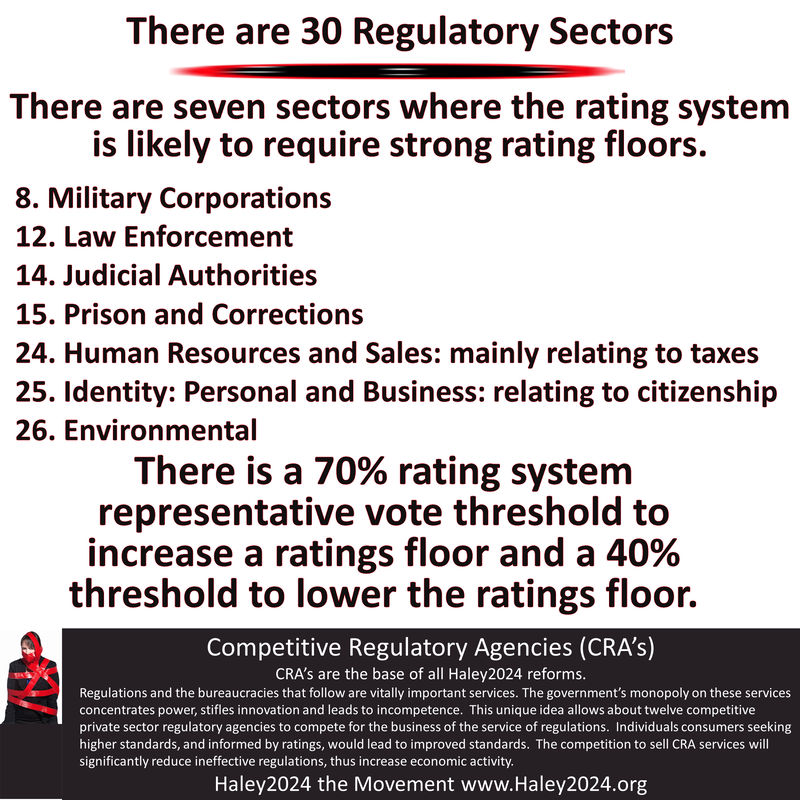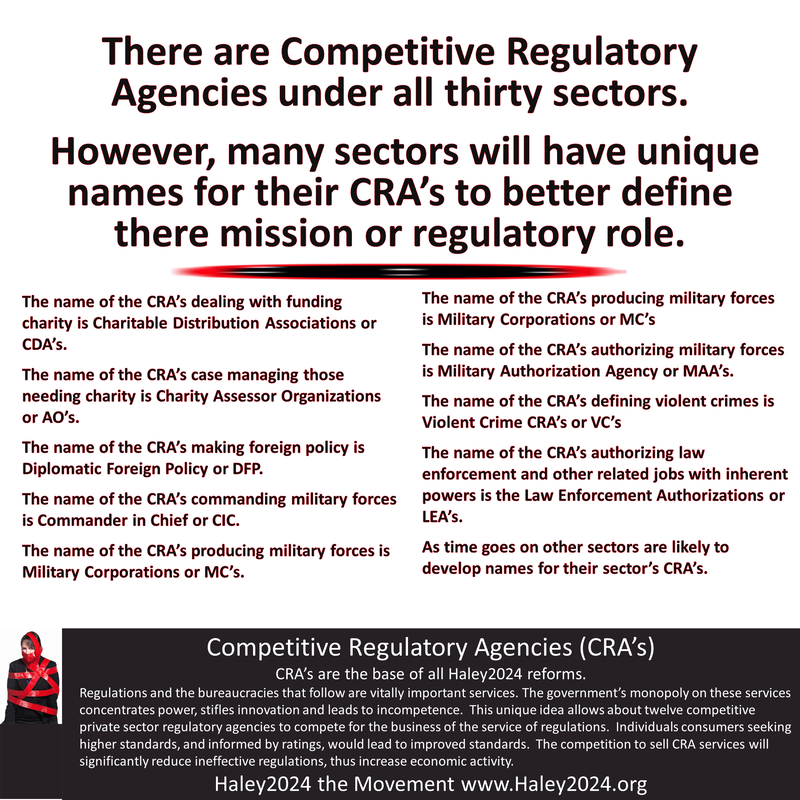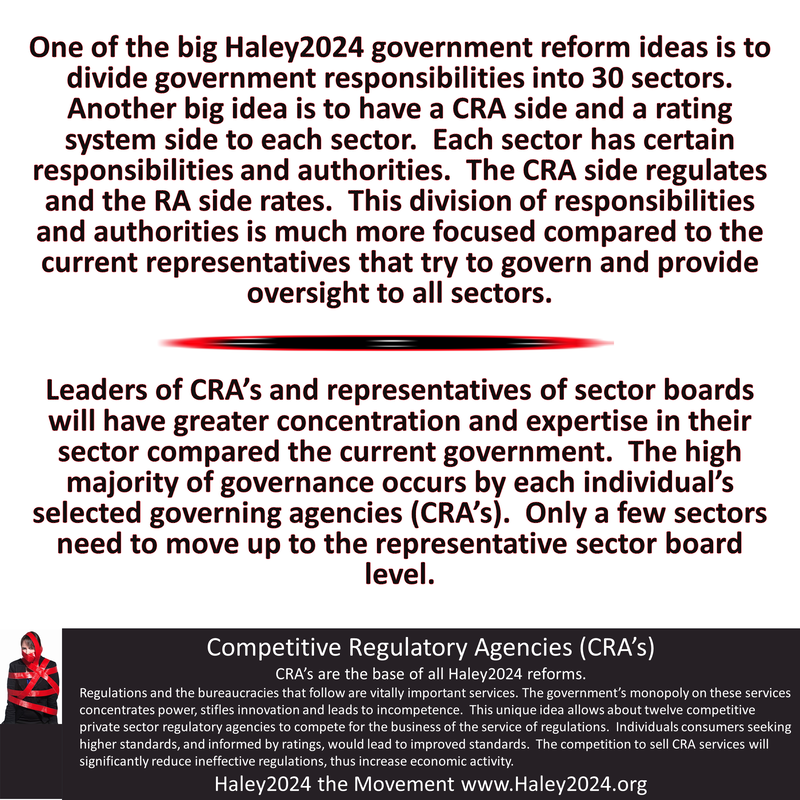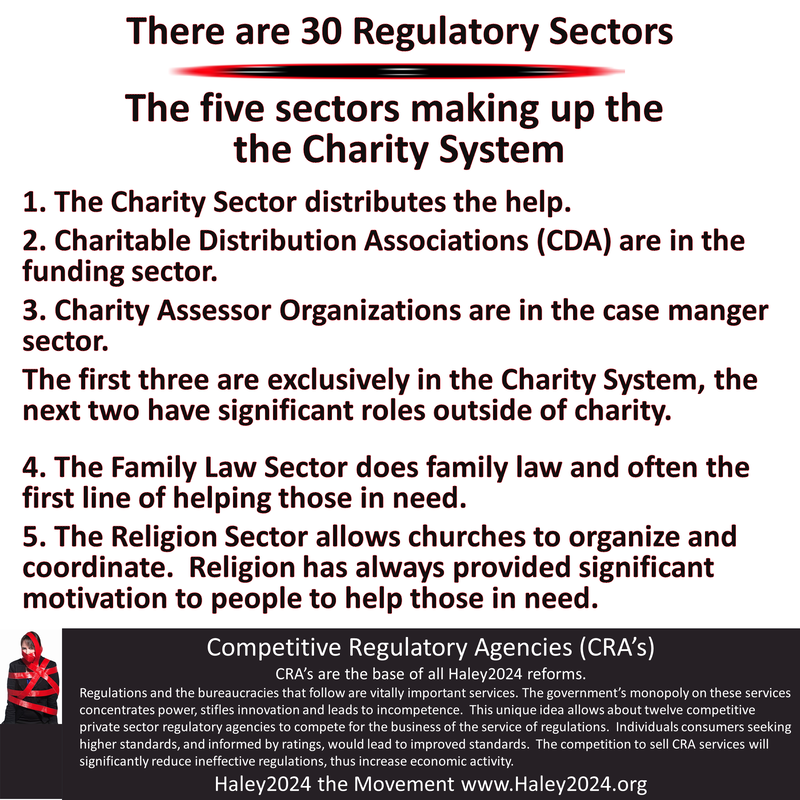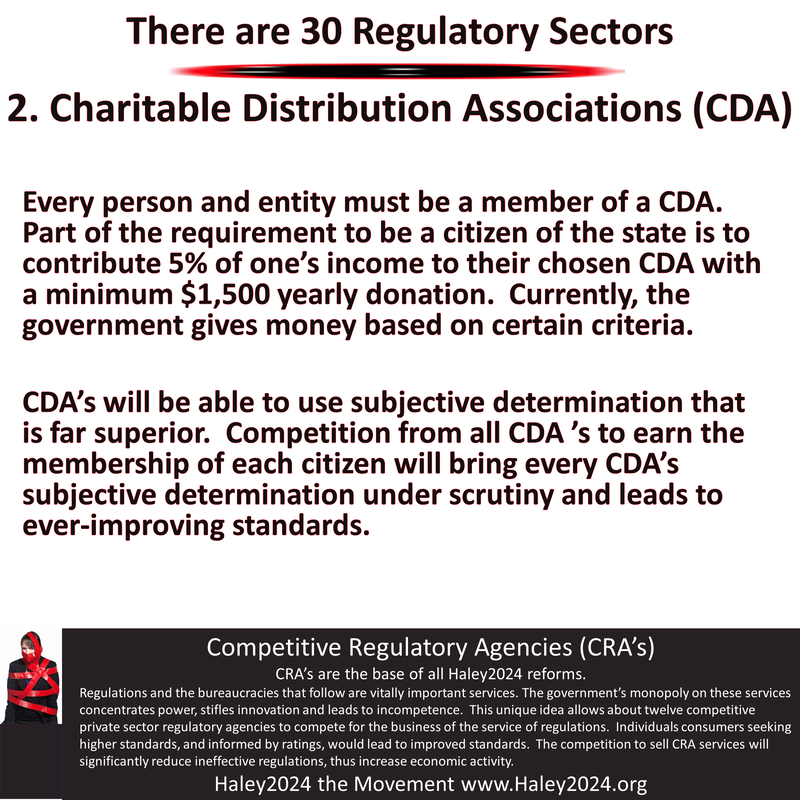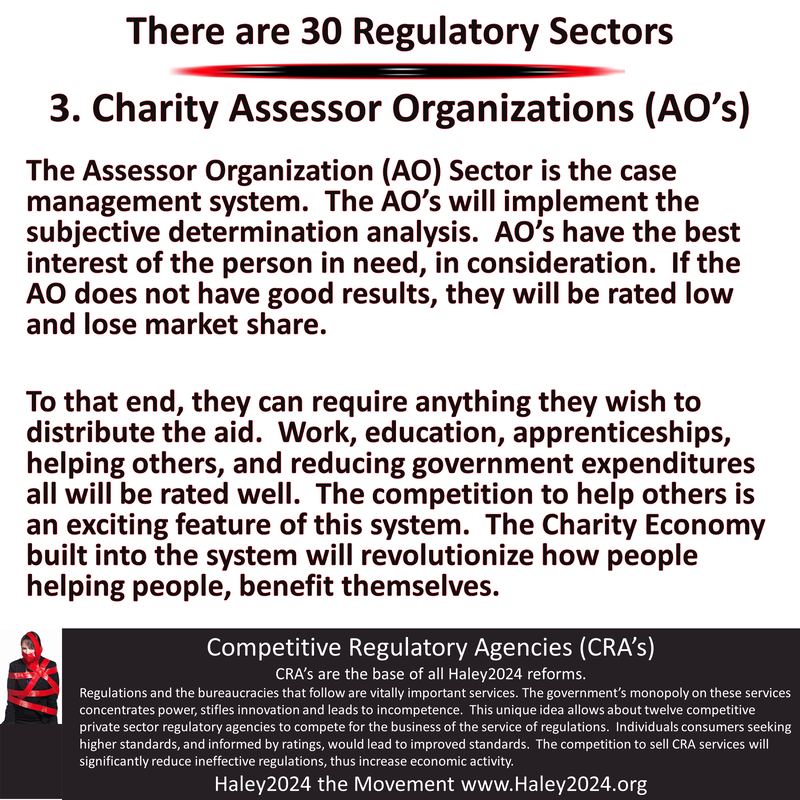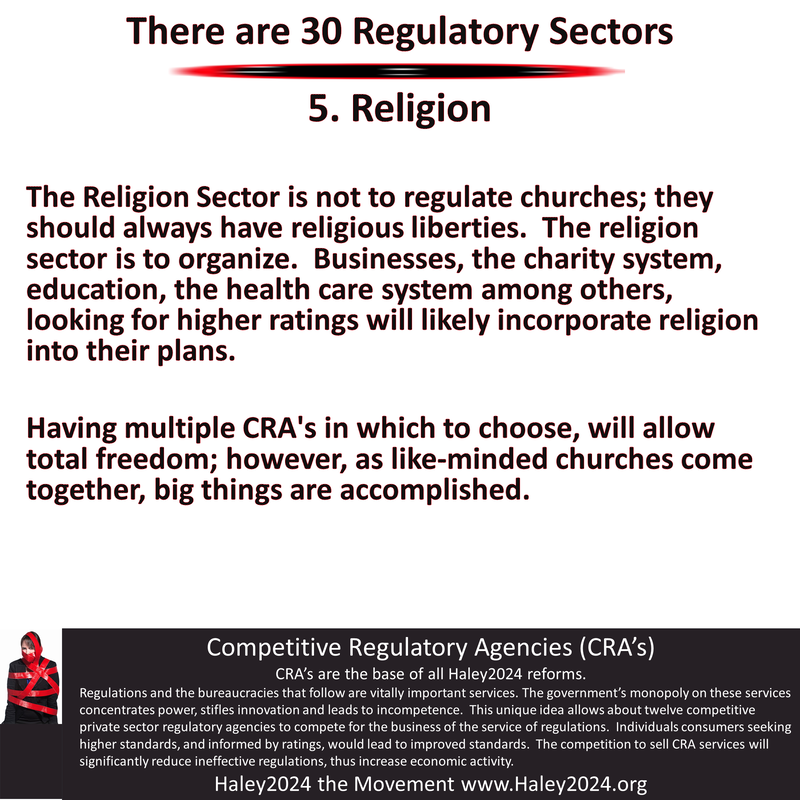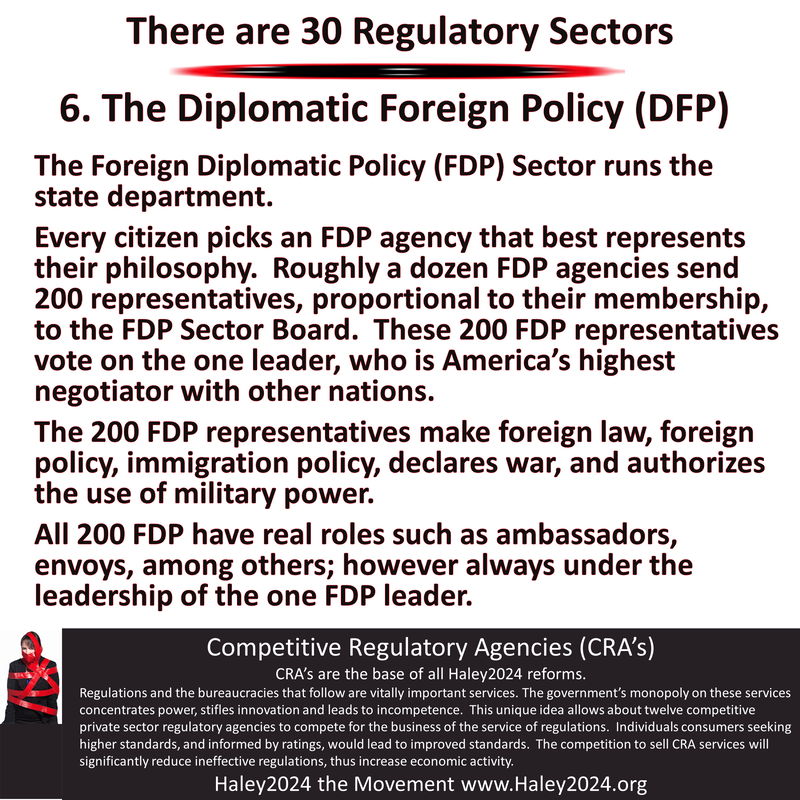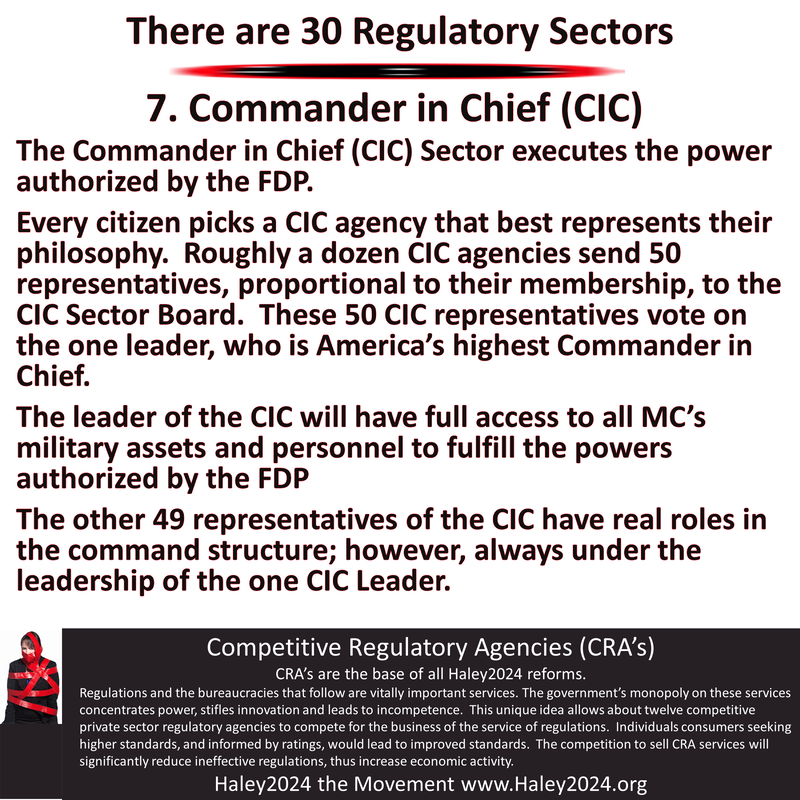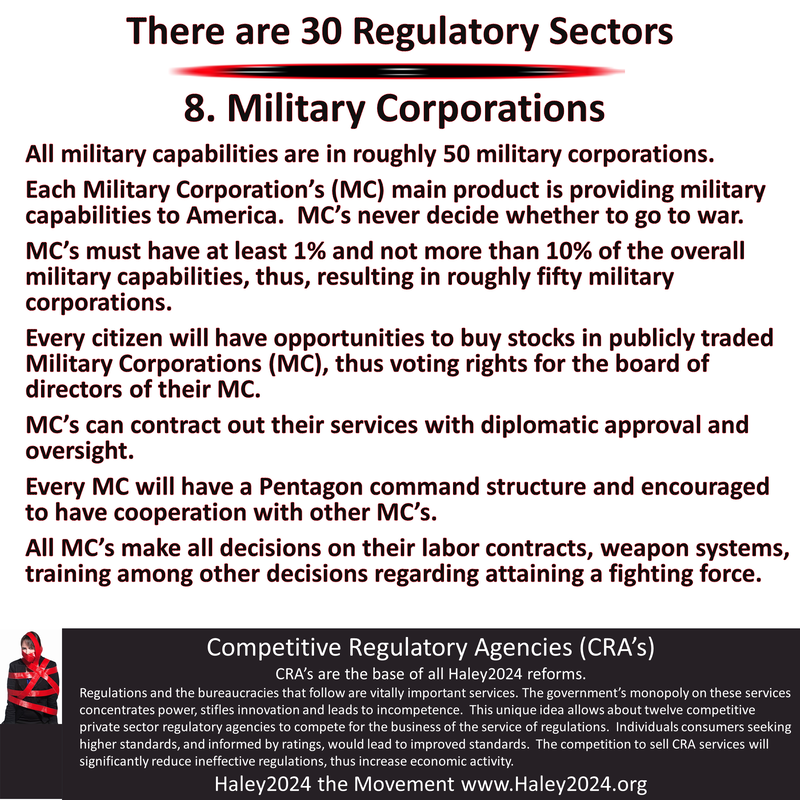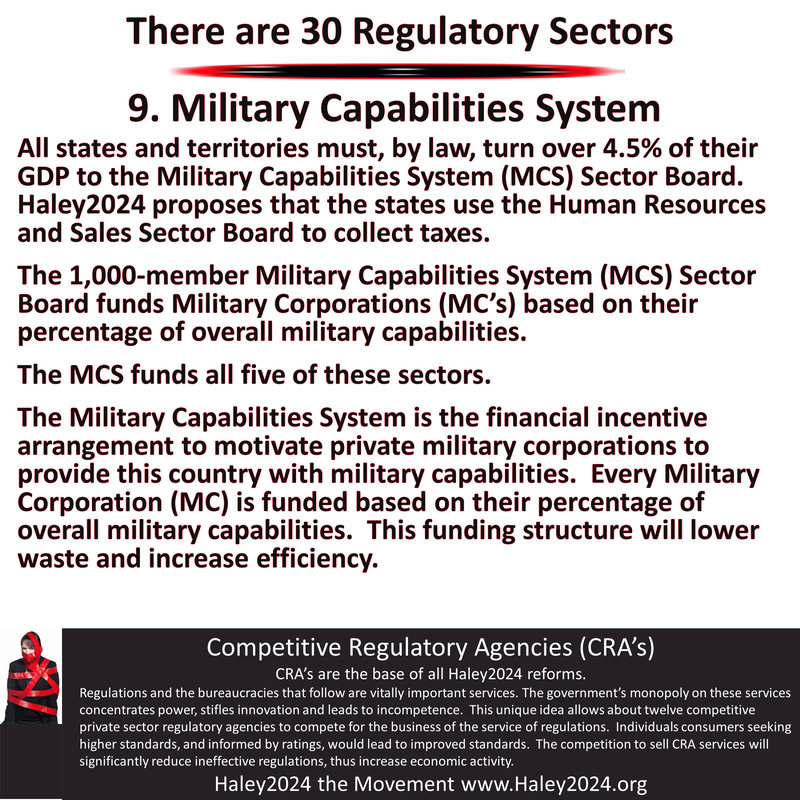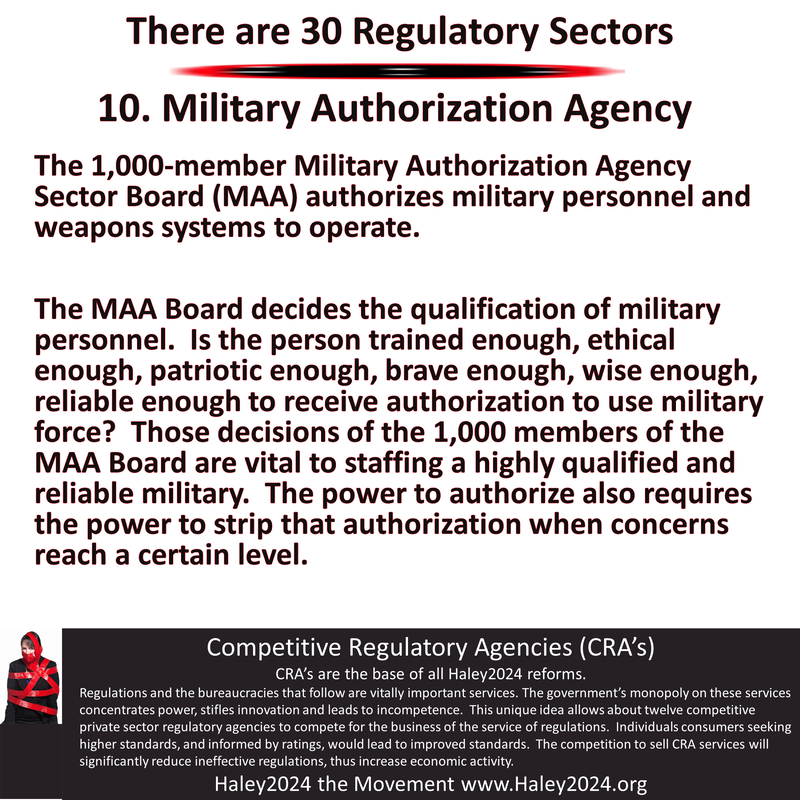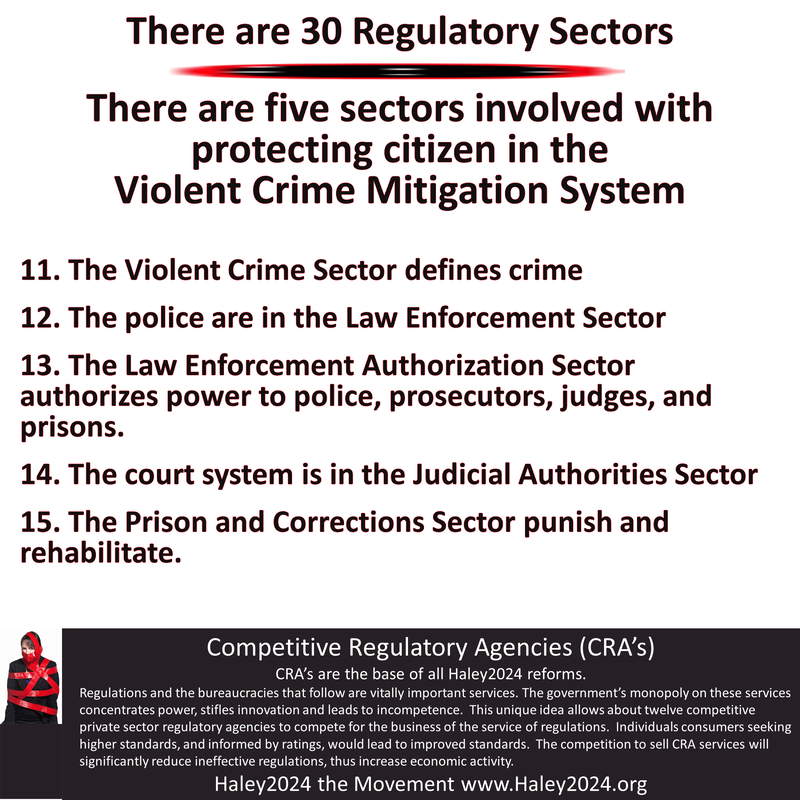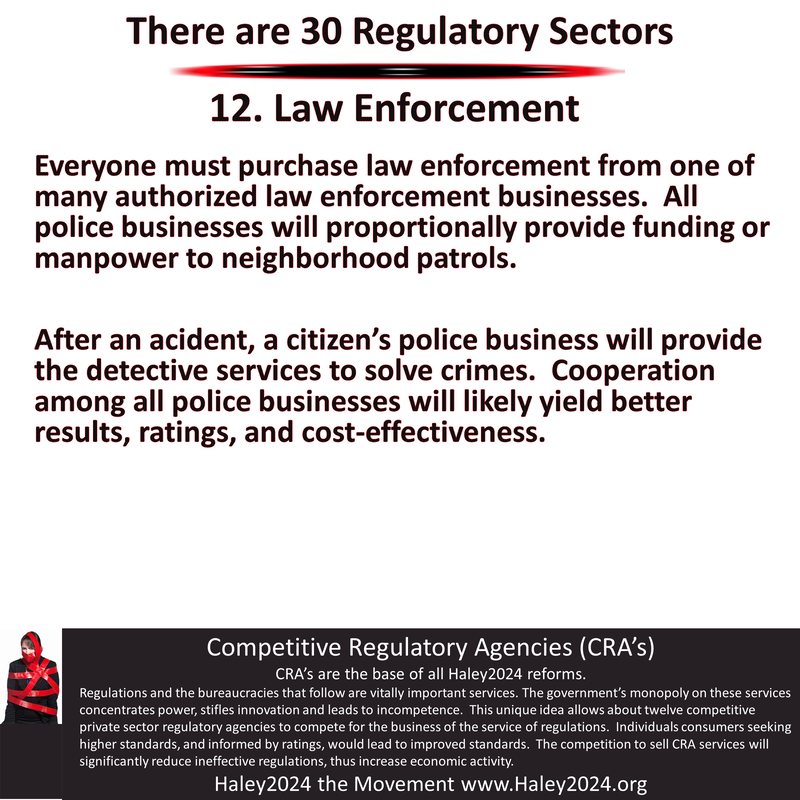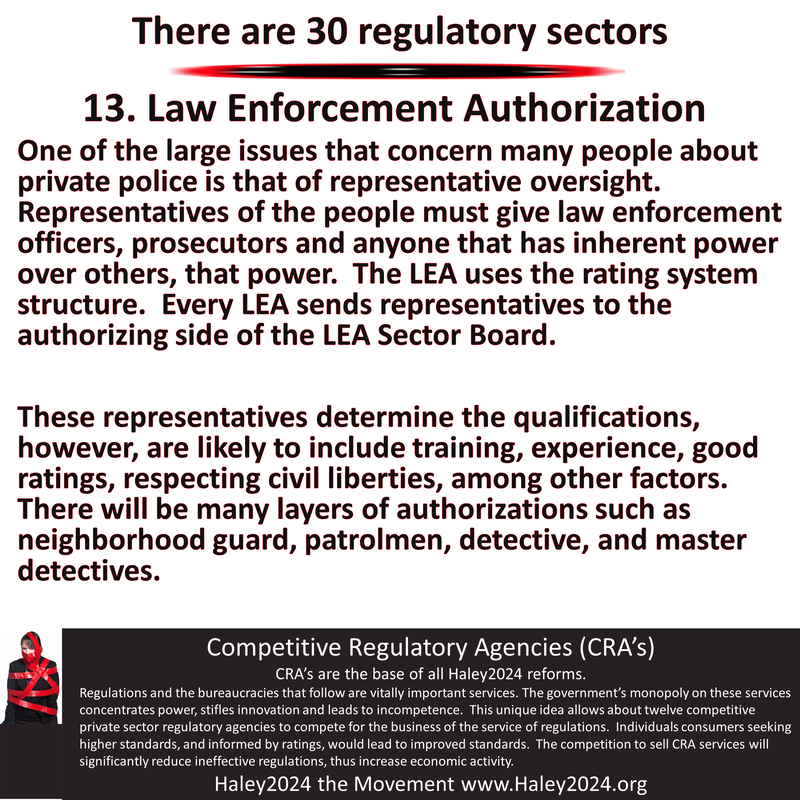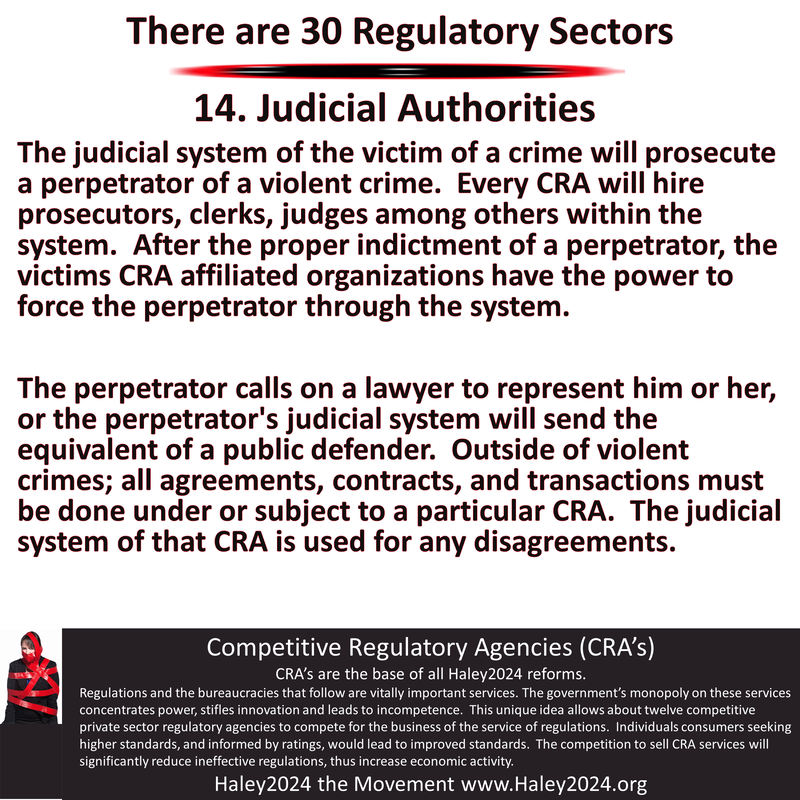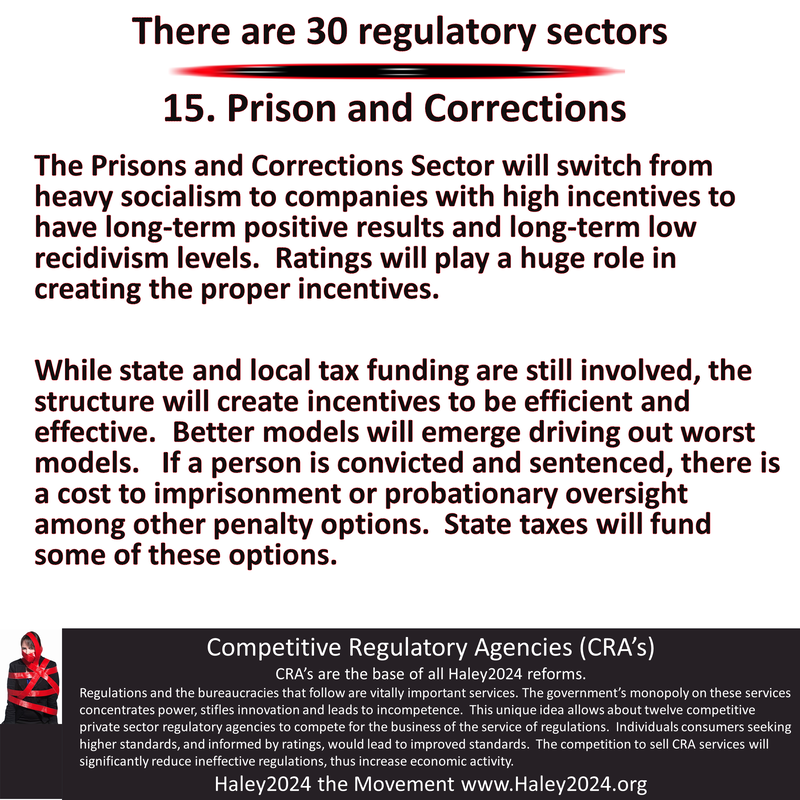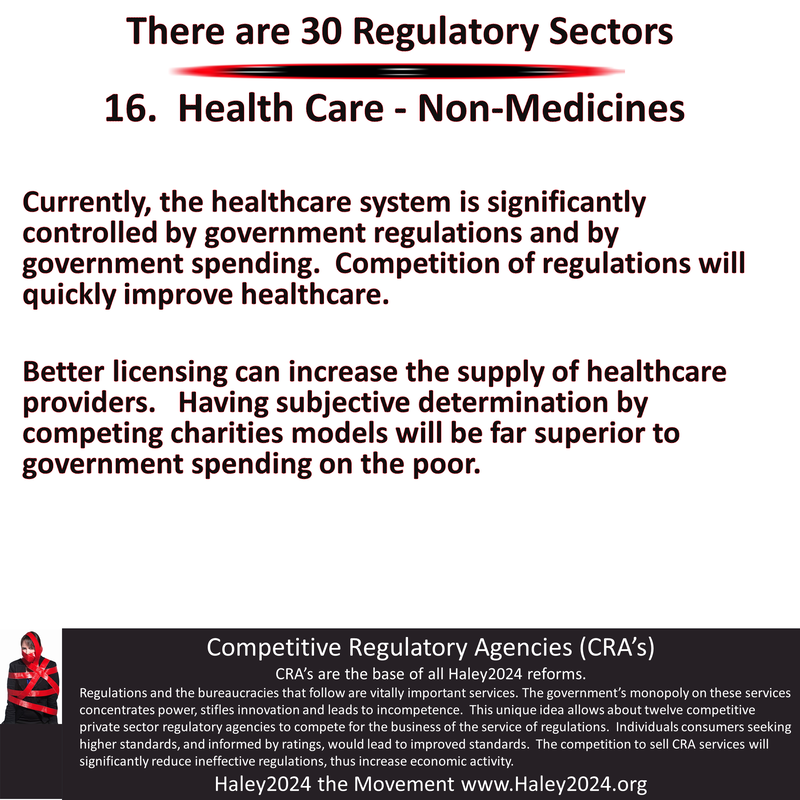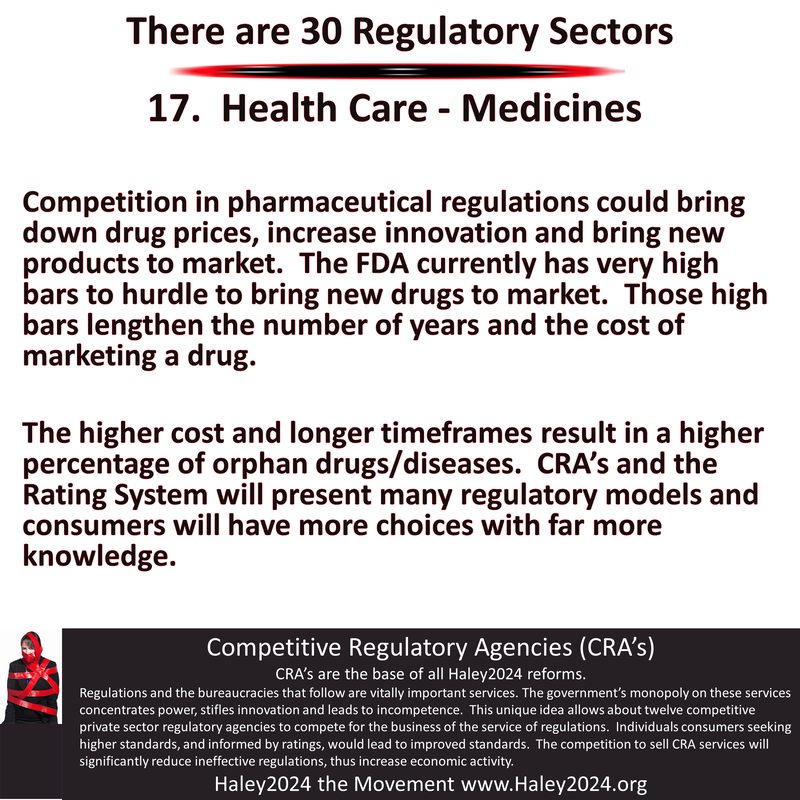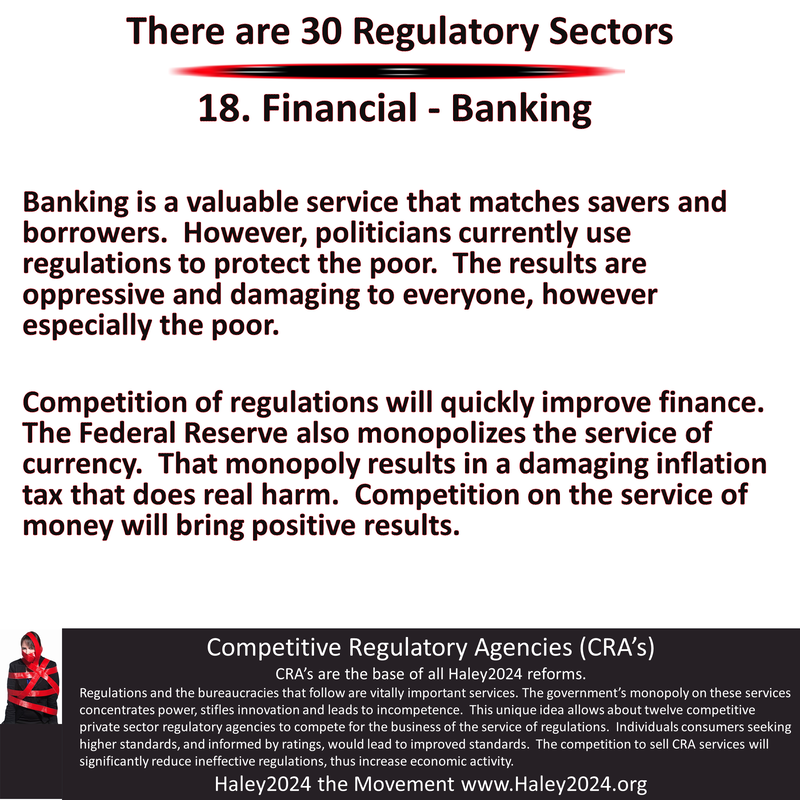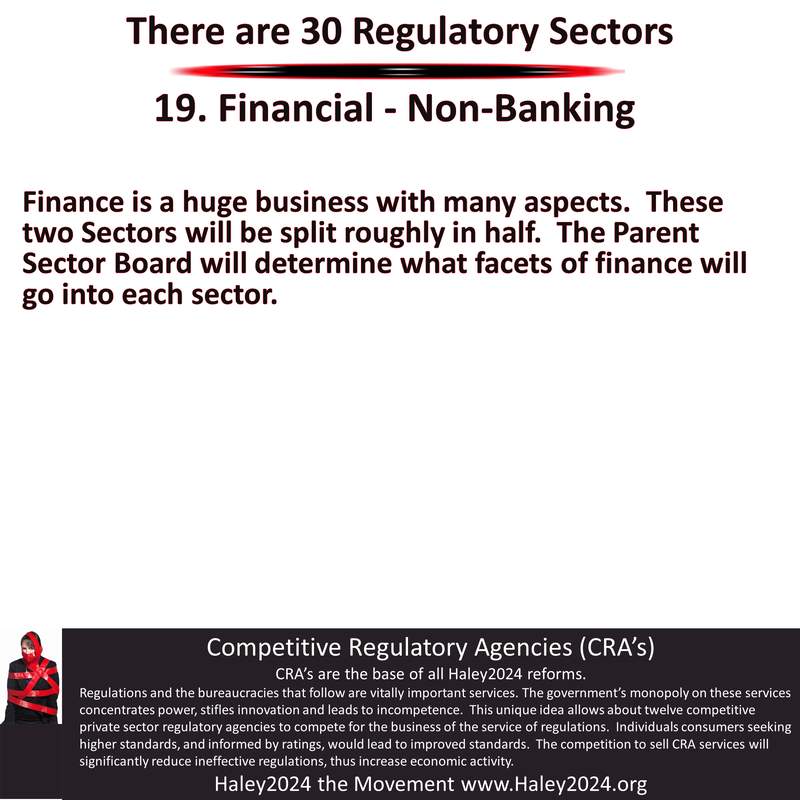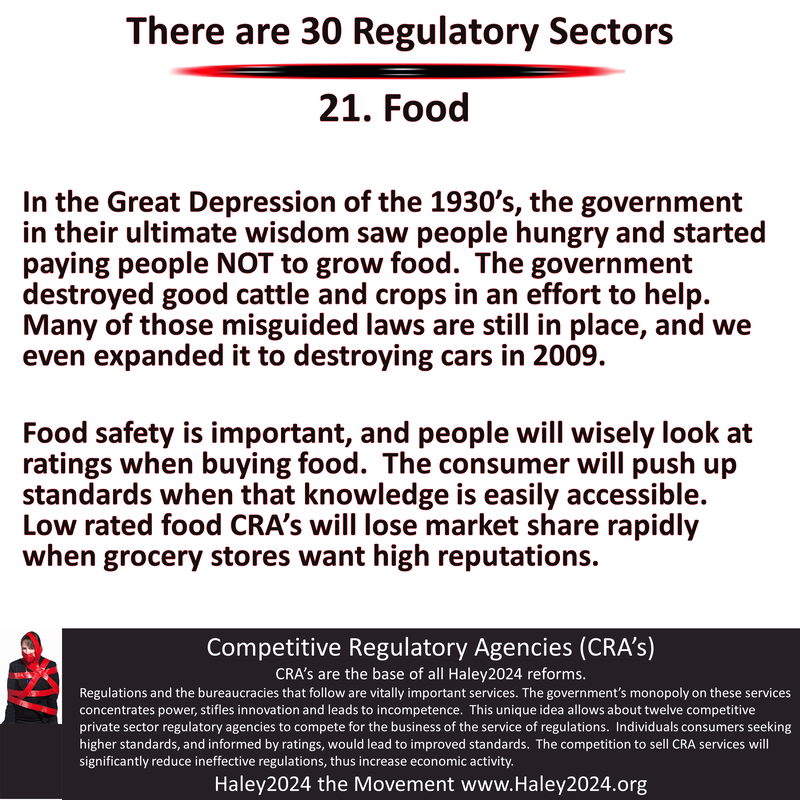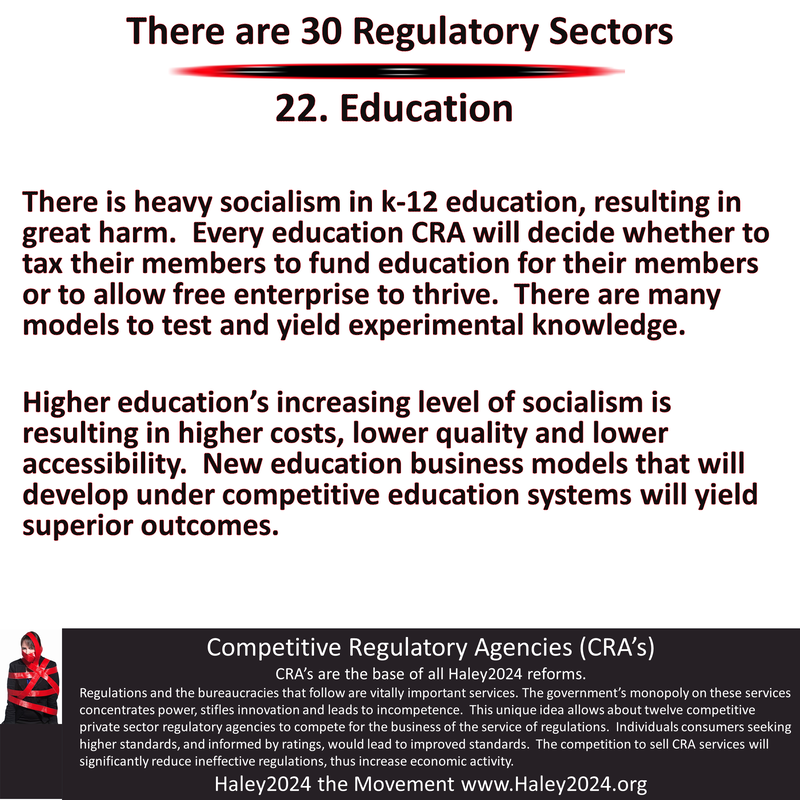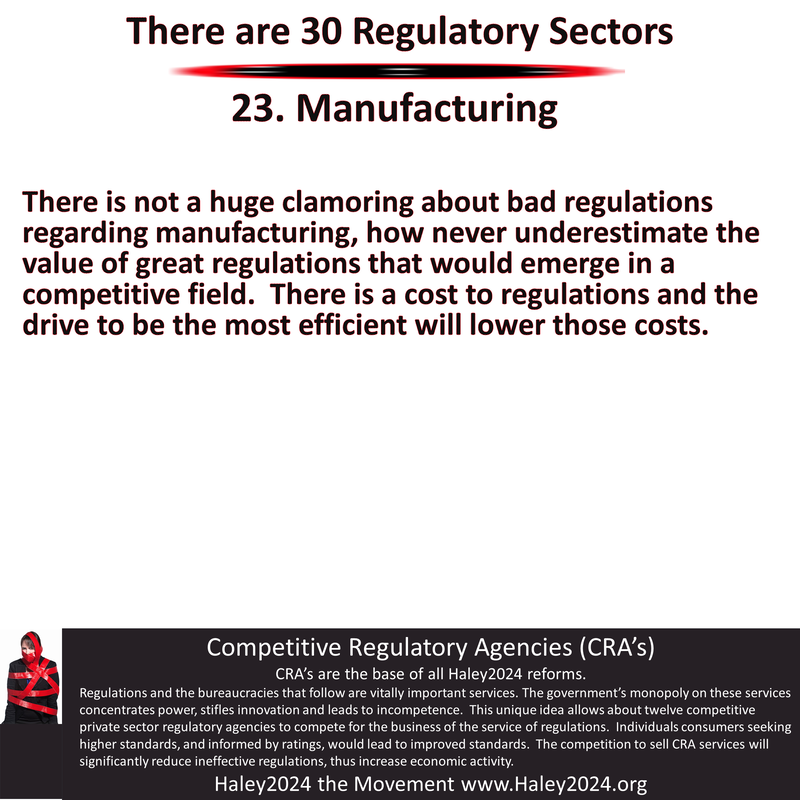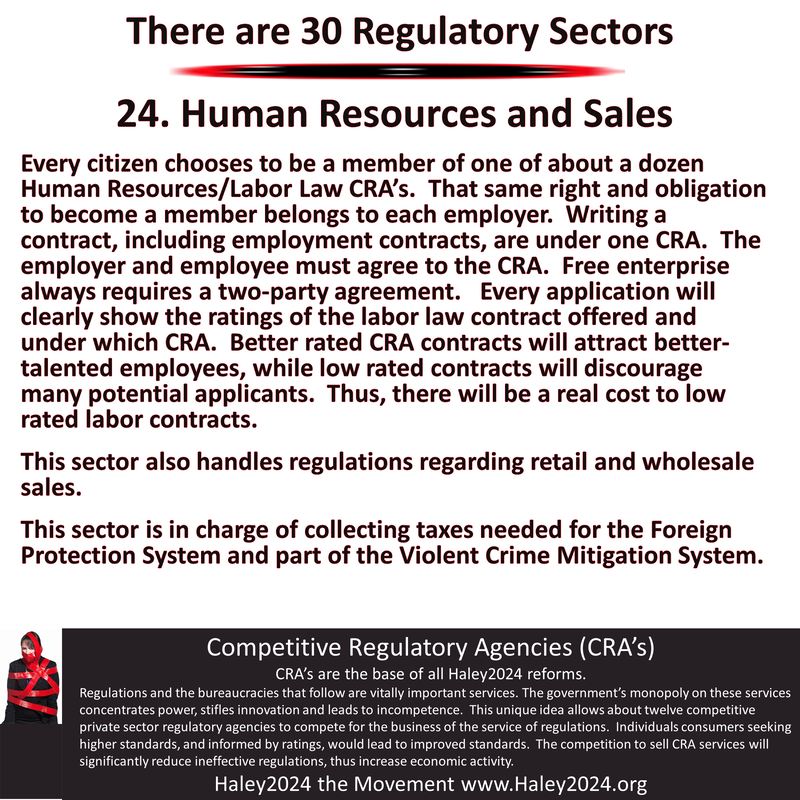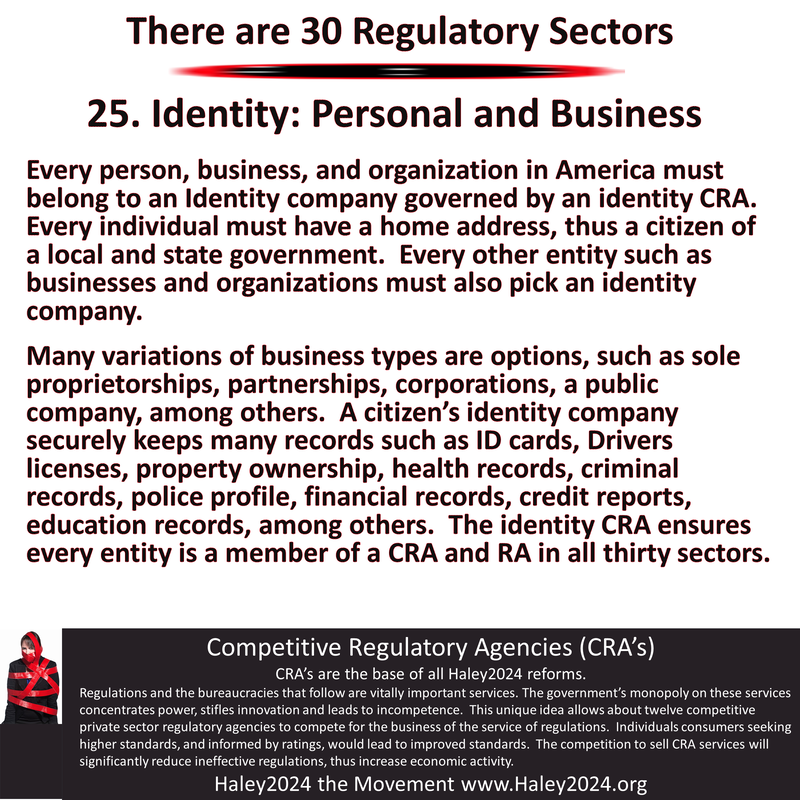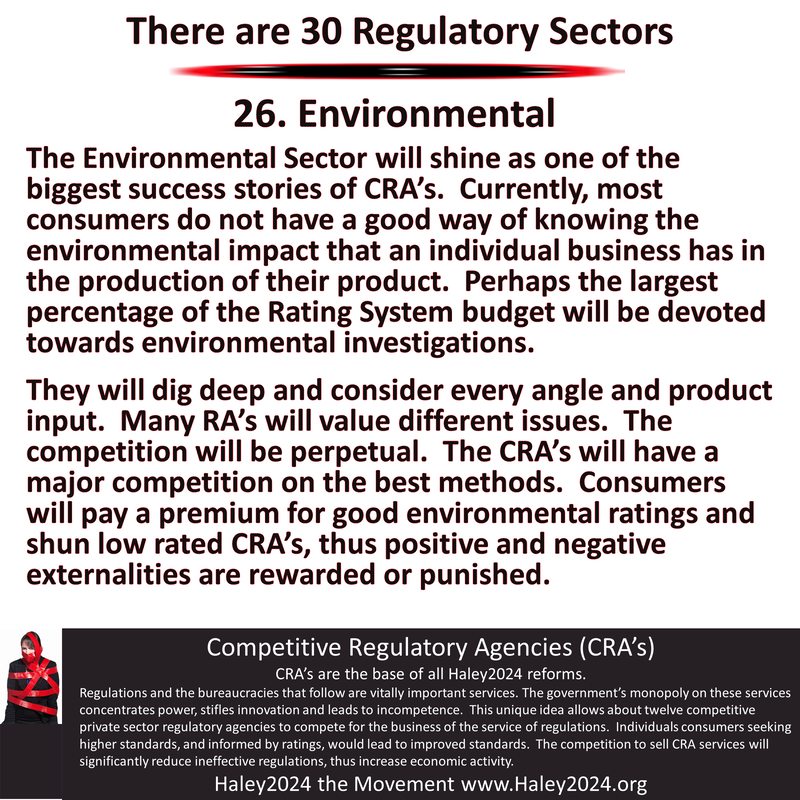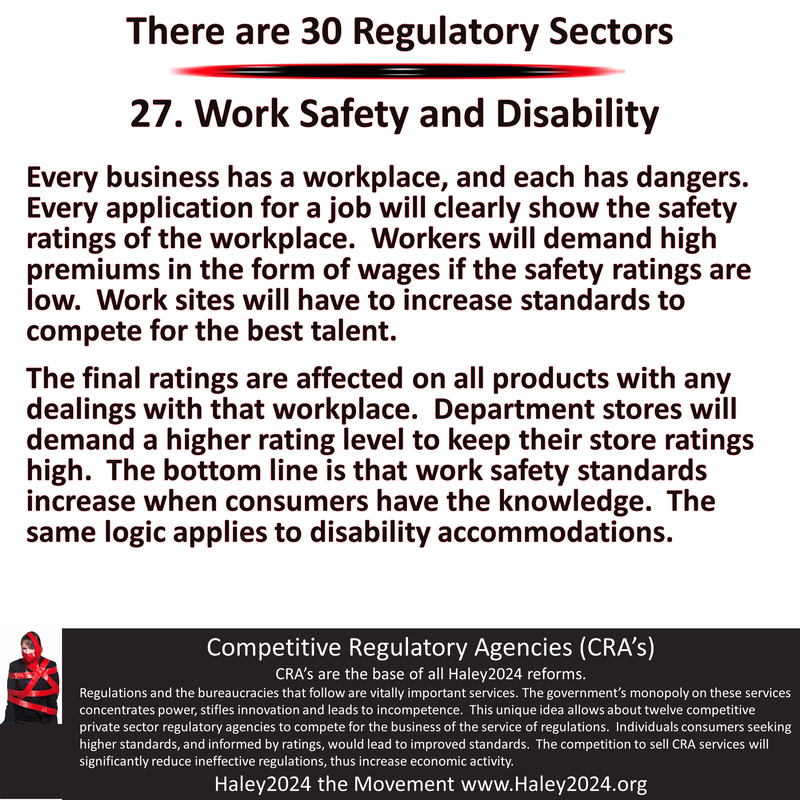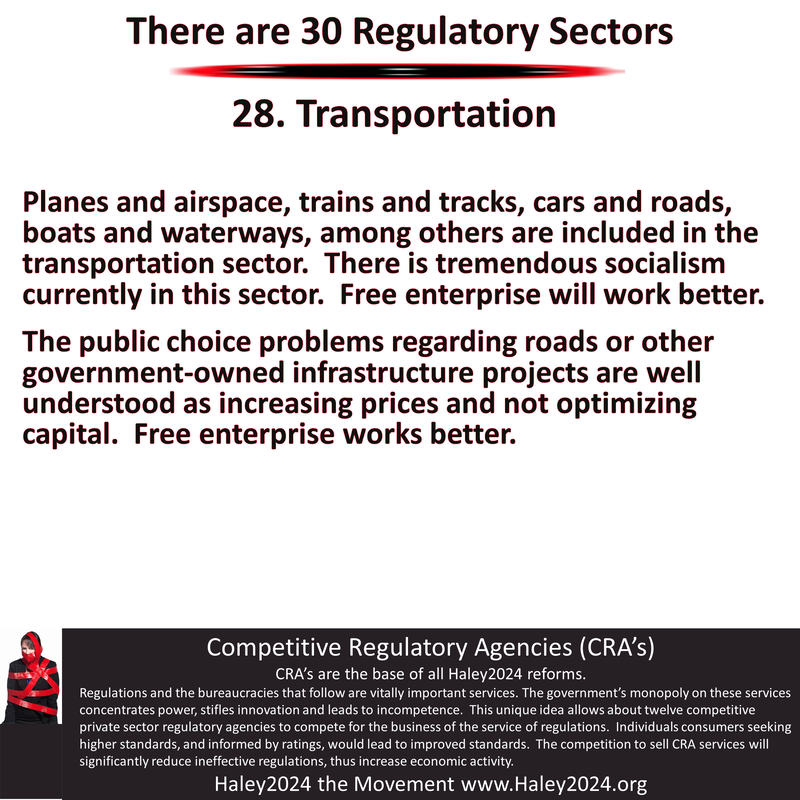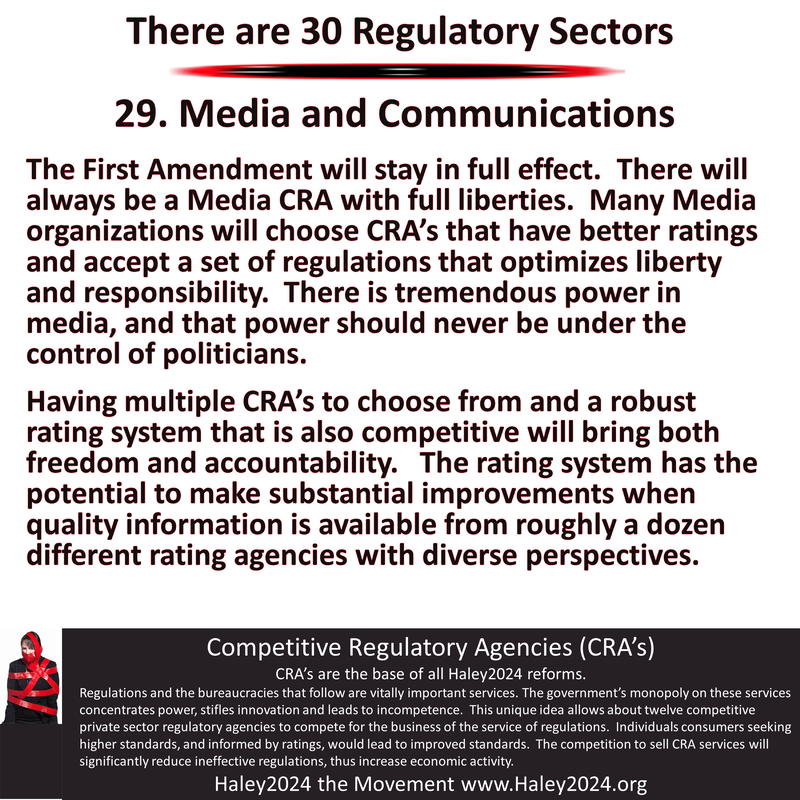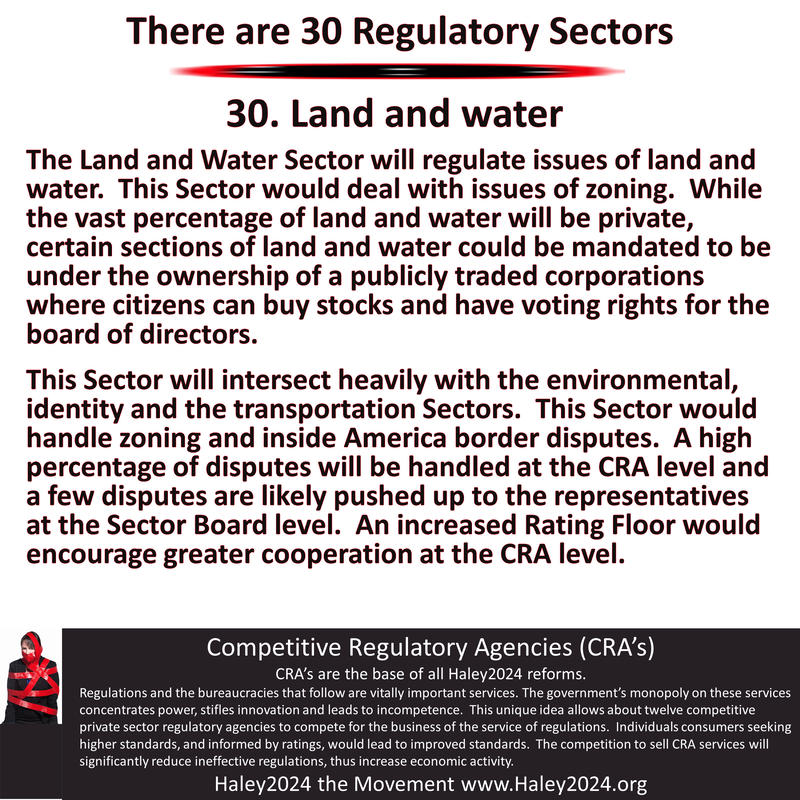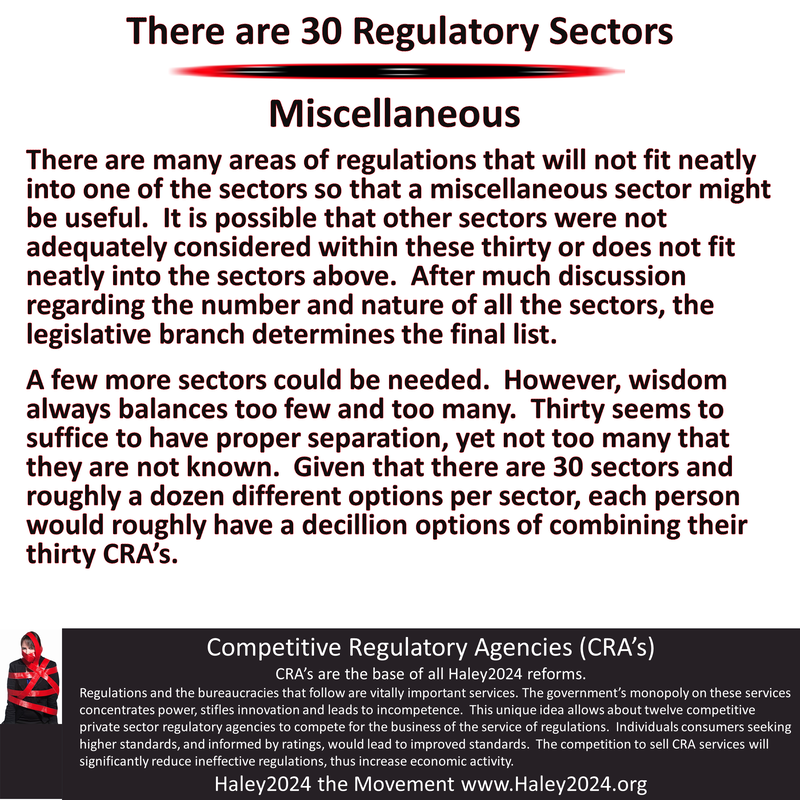The Sector Boards
|
We currently have three levels of government. The city, state and federal governments all try to have some control over most of these sectors. All the sectors mean, everything currently regulated, owned or otherwise controlled by the government. The three branches of government at each level also try to exert their power when they can. The power struggles and multiple controlling interests do not often result in the best regulations, bureaucracies nor structure for people and organizations to thrive with liberty and justice.
|
|
We currently also have one regulatory system to exist in, in all the relevant levels, with all the competing inputs from the different branches. Thus we do not have choices. For example, one has only one local school system to choose from based on their address. The school system has city, state and federal inputs. The inputs have come heavily from the legislative, judicial and executive branches. Under the current system, the winners of elections are in charge of all these areas of our lives, regardless if one voted for them or not
|
|
Under the Haley2024’s CRA model, every person, business or entity picks one private Competitive Regulatory Agency (CRA) to regulate them per sector. Regulations are split up into 30 sectors. Thus, every entity is making 30 choices. Citizens concentrate on their preference in each sector when making their choices.
Instead of multiple politicians who are winners of elections, fighting to control citizens with regulations and bureaucracy, multiple CRA’s will fight for every citizen’s business of serving them with the best regulations. |
|
|
|
At the state level, a citizen, business, organization or shall we say every entity will have to become a member of one CRA in every sector. They will have roughly a dozen different CRA’s to pick from in every sector. There is a full realization that many sectors will have very low applicability to many entities. However, it is mandatory to give proper representation at sector boards and to be there when it becomes applicable. Most CRA’s will have very low pricing if there is not much to do.
|
|
Every sector will have a rating system specializing in just that sector. Every entity will also become a member of a rating agency in every Sector. After considerable study and discussion, the number and names of sectors might adjust slightly. The following are quick descriptions of each sector with links to some, with their page. There will be considerable overlap between sectors. The Parent Sector Board will draw the lines, and CRA's will work with each other because consumers/members will demand cooperation.
|
|
Updated 9-12-2021 version above
These explanations below were created in 2019. The basic structure remains; however, small modifications were made to correct inconsistencies or to address conflicts.
This page is designed to give short explanations and thought patterns for each of the Sectors within the CRA Structure.
There are videos for each of the Sectors on the Constitutional Amendment Page.
The five sectors making up the
|
1. Charity
The Charity Sector is where the help happens. The regulations surrounding charities could increase or decrease efficiency, productivity and proper use of resources. Competition and ratings will be valuable.
The food sector will help create many models of food distribution. The medical sector will assist in providing many healthcare models to assist those in need. The ever-increasing standards created by the competitive nature of the system will allow resources to reach further. |
2. Charitable Distribution Associations (CDA)
Every person and entity must be a member of a CDA. Part of the requirement to be a citizen of the state is to contribute 5% of one’s income to their chosen CDA with a minimum $1,500 yearly donation. Currently, the government gives money based on certain criteria.
CDA’s will be able to use subjective determination that is far superior. Competition from all CDA ’s to earn the membership of each citizen will bring every CDA’s subjective determination under scrutiny and leads to ever-improving standards. |
3. Charity Assessor Organizations (AO’s)
The Assessor Organization (AO) Sector is the case management system. The AO’s will implement the subjective determination analysis. AO’s have the best interest of the person in need, in consideration. If the AO does not have good results, they will be rated low and lose market share.
To that end, they can require anything they wish to distribute the aid. Work, education, apprenticeships, helping others, and reducing government expenditures all will be rated well. The competition to help others is an exciting feature of this system. The Charity Economy built into the system will revolutionize how people helping people, benefit themselves. |
4. Family Law
There are hundreds of issues of family law. There is much debate regarding each issue. Many people want marriage laws to be conservative, and others want much more liberal laws. Correct laws regarding children are vital, so a monopoly on those laws are not wise.
It is not just two ways per issue, but dozens of variations surrounding each of the hundreds of issues. Nobody should force others to live under a system of laws with which he or she disagrees. If there were a dozen family law CRA’s with different regulations under each, everyone would have a close fit for there values. |
5. Religion
The Religion Sector is not to regulate churches; they should always have religious liberties. The religion sector is to organize. Businesses, the charity system, education, the health care system among others, looking for higher ratings will likely incorporate religion into their plans.
Having multiple CRA's in which to choose, will allow total freedom; however, as like-minded churches come together, big things are accomplished. |
There are five sectors involved with protecting our nation in the
|
6. The Diplomatic Foreign Policy (DFP)
The Foreign Diplomatic Policy (FDP) Sector runs the state department.
Every citizen picks an FDP agency that best represents their philosophy. Roughly a dozen FDP agencies send 200 representatives, proportional to their membership, to the FDP Sector Board. These 200 FDP representatives vote on the one leader, who is America’s highest negotiator with other nations. The 200 FDP representatives make foreign law, foreign policy, immigration policy, declares war, and authorizes the use of military power. All 200 FDP have real roles such as ambassadors, envoys, among others; however always under the leadership of the one FDP leader. |
7. Commander in Chief (CIC)
The Commander in Chief (CIC) Sector executes the power authorized by the FDP.
Every citizen picks a CIC agency that best represents their philosophy. Roughly a dozen CIC agencies send 50 representatives, proportional to their membership, to the CIC Sector Board. These 50 CIC representatives vote on the one leader, who is America’s highest Commander in Chief. The leader of the CIC will have full access to all MC’s military assets and personnel to fulfill the powers authorized by the FDP The other 49 representatives of the CIC have real roles in the command structure; however, always under the leadership of the one CIC Leader. |
8. Military Corporations
All military capabilities are in roughly 50 military corporations.
Each Military Corporation’s (MC) main product is providing military capabilities to America. MC’s never decide whether to go to war. MC’s must have at least 1% and not more than 10% of the overall military capabilities, thus, resulting in roughly fifty military corporations. Every citizen will have opportunities to buy stocks in publicly traded Military Corporations (MC), thus voting rights for the board of directors of their MC. MC’s can contract out their services with diplomatic approval and oversight. Every MC will have a Pentagon command structure and encouraged to have cooperation with other MC’s. All MC’s make all decisions on their labor contracts, weapon systems, training among other decisions regarding attaining a fighting force. |
9. Military Capabilities SystemAll states and territories must, by law, turn over 4.5% of their GDP to the Military Capabilities System (MCS) Sector Board. Haley2024 proposes that the states use the Human Resources and Sales Sector Board to collect taxes.
The 1,000-member Military Capabilities System (MCS) Sector Board funds Military Corporations (MC’s) based on their percentage of overall military capabilities. The MCS funds all five of these sectors. The Military Capabilities System is the financial incentive arrangement to motivate private military corporations to provide this country with military capabilities. Every Military Corporation (MC) is funded based on their percentage of overall military capabilities. This funding structure will lower waste and increase efficiency. |
10. Military Authorization Agency
The 1,000-member Military Authorization Agency Sector Board (MAA) authorizes military personnel and weapons systems to operate.
The MAA Board decides the qualification of military personnel. Is the person trained enough, ethical enough, patriotic enough, brave enough, wise enough, reliable enough to receive authorization to use military force? Those decisions of the 1,000 members of the MMA Board are vital to staffing a highly qualified and reliable military. The power to authorize also requires the power to strip that authorization when concerns reach a certain level. |
There are five sectors involved with protecting citizen in the Violent Crime Mitigation System
11. The Violent Crime Sector defines crime
12. The police are in the Law Enforcement Sector 13. The Law Enforcement Authorization Sector authorizes power to police, prosecutors, judges, and prisons. 14. The court system is in the Judicial Authorities Sector 15. The Prison and Corrections Sector punish and rehabilitate. |
11. Violent Crime
Violent crimes are assault and battery. These are crimes against a person. These will include physical attacks, threats, and certain thefts. All other crimes are within other sectors. The parent sector board decides the scope of authority for all thirty sectors. The VC and RA parts of the Violent Crime Sector Board are both structured like a rating system.
Everyone picks which VC and RA agencies to put his or her trust. The VC’s and RA’s proportionally send representatives to their respective sides of the Violent Crime Sector Board. The VC side decides what a violent crime is and the range of punishment for each violent crime. The judge and juries still do the sentencing. |
12. Law Enforcement
Everyone must purchase law enforcement from one of many authorized law enforcement businesses. All police businesses will proportionally provide funding or manpower to neighborhood patrols.
After an acident, a citizen’s police business will provide the detective services to solve crimes. Cooperation among all police businesses will likely yield better results, ratings, and cost-effectiveness. |
13. Law Enforcement AuthorizationOne of the large issues that concern many people about private police is that of representative oversight. Representatives of the people must give law enforcement officers, prosecutors and anyone that has inherent power over others, that power. The LEA uses the rating system structure. Every LEA sends representatives to the authorizing side of the LEA Sector Board.
These representatives determine the qualifications, however, are likely to include training, experience, good ratings, respecting civil liberties, among other factors. There will be many layers of authorizations such as neighborhood guard, patrolmen, detective, and master detectives. |
14. Judicial Authorities
The judicial system of the victim of a crime will prosecute a perpetrator of a violent crime. Every CRA will hire prosecutors, clerks, judges among others within the system. After the proper indictment of a perpetrator, the victims CRA affiliated organizations have the power to force the perpetrator through the system.
The perpetrator calls on a lawyer to represent him or her, or the perpetrator's judicial system will send the equivalent of a public defender. Outside of violent crimes; all agreements, contracts, and transactions must be done under or subject to a particular CRA. The judicial system of that CRA is used for any disagreements. |
15. Prison and Corrections
The Prisons and Corrections Sector will switch from heavy socialism to companies with high incentives to have long-term positive results and long-term low recidivism levels. Ratings will play a huge role in creating the proper incentives.
While state and local tax funding are still involved, the structure will create incentives to be efficient and effective. Better models will emerge driving out worst models. If a person is convicted and sentenced, there is a cost to imprisonment or probationary oversight among other penalty options. State taxes will fund some of these options. |
16. Health Care - Non-Medicines
Currently, the healthcare system is significantly controlled by government regulations and by government spending. Competition of regulations will quickly improve healthcare.
Better licensing can increase the supply of healthcare providers. Having subjective determination by competing charities models will be far superior to government spending on the poor. |
17. Health Care - Medicines
Competition in pharmaceutical regulations could bring down drug prices, increase innovation and bring new products to market. The FDA currently has very high bars to hurdle to bring new drugs to market. Those high bars lengthen the number of years and the cost of marketing a drug.
The higher cost and longer timeframes result in a higher percentage of orphan drugs/diseases. CRA’s and the Rating System will present many regulatory models and consumers will have more choices with far more knowledge. |
18. Financial - Banking
Banking is a valuable service that matches savers and borrowers. However, politicians currently use regulations to protect the poor. The results are oppressive and damaging to everyone, however especially the poor.
Competition of regulations will quickly improve finance. The Federal Reserve also monopolizes the service of currency. That monopoly results in a damaging inflation tax that does real harm. Competition on the service of money will bring positive results. |
20. Insurance
Many people rightfully and often wrongly blame insurance companies for bad experiences. Politicians who are woefully under-educated on business realities often write bad regulations endeavoring to help, however, leads to many unintentional harms.
Politicians then try to fix those harms and do further damage. Having many insurance regulatory systems will surely increase quality and customer experiences. Quality ratings in this area will bring much-needed knowledge that will yield real competition. |
21. Food
In the Great Depression of the 1930’s, the government in their ultimate wisdom saw people hungry and started paying people NOT to grow food. The government destroyed good cattle and crops in an effort to help. Many of those misguided laws are still in place, and we even expanded it to destroying cars in 2009.
Food safety is important, and people will wisely look at ratings when buying food. The consumer will push up standards when that knowledge is easily accessible. Low rated food CRA’s will lose market share rapidly when grocery stores want high reputations. |
22. Education
There is heavy socialism in k-12 education, resulting in great harm. Every education CRA will decide whether to tax their members to fund education for their members or to allow free enterprise to thrive. There are many models to test and yield experimental knowledge.
Higher education’s increasing level of socialism is resulting in higher costs, lower quality and lower accessibility. New education business models that will develop under competitive education systems will yield superior outcomes. |
24. Human Resources and Sales
Every citizen chooses to be a member of one of about a dozen Human Resources/Labor Law CRA’s. That same right and obligation to become a member belongs to each employer. Writing a contract, including employment contracts, are under one CRA. The employer and employee must agree to the CRA. Free enterprise always requires a two-party agreement. Every application will clearly show the ratings of the labor law contract offered and under which CRA. Better rated CRA contracts will attract better-talented employees, while low rated contracts will discourage many potential applicants. Thus, there will be a real cost to low rated labor contracts.
This sector also handles regulations regarding retail and wholesale sales. This sector is in charge of collecting taxes needed for the Foreign Protection System and part of the Violent Crime Mitigation System. |
25. Identity: Personal and Business
Every person, business, and organization in America must belong to an Identity company governed by an identity CRA. Every individual must have a home address, thus a citizen of a local and state government. Every other entity such as businesses and organizations must also pick an identity company.
Many variations of business types are options, such as sole proprietorships, partnerships, corporations, a public company, among others. A citizen’s identity company securely keeps many records such as ID cards, Drivers licenses, property ownership, health records, criminal records, police profile, financial records, credit reports, education records, among others. The identity CRA ensures every entity is a member of a CRA and RA in all thirty sectors. |
26. Environmental
The Environmental Sector will shine as one of the biggest success stories of CRA’s. Currently, most consumers do not have a good way of knowing the environmental impact that an individual business has in the production of their product. Perhaps the largest percentage of the Rating System budget will be devoted towards environmental investigations.
They will dig deep and consider every angle and product input. Many RA’s will value different issues. The competition will be perpetual. The CRA’s will have a major competition on the best methods. Consumers will pay a premium for good environmental ratings and shun low rated CRA’s, thus positive and negative externalities are rewarded or punished. |
27. Work Safety and DisabilityEvery business has a workplace, and each has dangers. Every application for a job will clearly show the safety ratings of the workplace. Workers will demand high premiums in the form of wages if the safety ratings are low. Work sites will have to increase standards to compete for the best talent.
The final ratings are affected on all products with any dealings with that workplace. Department stores will demand a higher rating level to keep their store ratings high. The bottom line is that work safety standards increase when consumers have the knowledge. The same logic applies to disability accommodations. |
28. Transportation
Planes and airspace, trains and tracks, cars and roads, boats and waterways, among others are included in the transportation sector. There is tremendous socialism currently in this sector. Free enterprise will work better.
The public choice problems regarding roads or other government-owned infrastructure projects are well understood as increasing prices and not optimizing capital. Free enterprise works better. |
29. Media and Communications
The First Amendment will stay in full effect. There will always be a Media CRA with full liberties. Many Media organizations will choose CRA’s that have better ratings and accept a set of regulations that optimizes liberty and responsibility. There is tremendous power in media, and that power should never be under the control of politicians.
Having multiple CRA’s to choose from and a robust Rating System that is also competitive will bring both freedom and accountability. The Rating System has the potential to make substantial improvements when quality information is available from roughly a dozen different rating agencies with diverse perspectives. |
30. Land and WaterThe Land and Water Sector will regulate issues of land and water. This Sector would deal with issues of zoning. While the vast percentage of land and water will be private, certain sections of land and water could be mandated to be under the ownership of a publicly traded corporations where citizens can buy stocks and have voting rights for the board of directors.
This Sector will intersect heavily with the environmental, identity and the transportation Sectors. This Sector would handle zoning and inside America border disputes. A high percentage of disputes will be handled at the CRA level and a few disputes are likely pushed up to the representatives at the Sector Board level. An increased Rating Floor would encourage greater cooperation at the CRA level. |
MiscellaneousThere are many areas of regulations that will not fit neatly into one of the sectors so that a miscellaneous sector might be useful. It is possible that other sectors were not adequately considered within these thirty or does not fit neatly into the sectors above. After much discussion regarding the number and nature of all the sectors, the legislative branch determines the final list.
A few more sectors could be needed. However, wisdom always balances too few and too many. Thirty seems to suffice to have proper separation, yet not too many that they are not known. Given that there are 30 Sectors and roughly a dozen different options per Sector, each person would roughly have a decillion options of combining their thirty CRA’s. |


